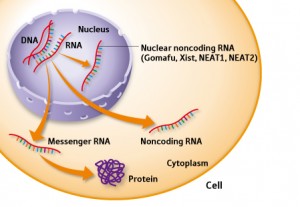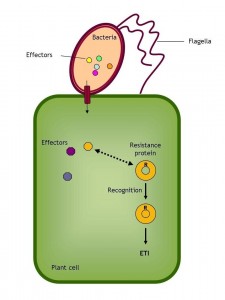 The previous post described an intelligent war between viruses and bacteria using self edits/mutations of their own DNA and RNA to make newly produced protein weapons. The bacterial weapons are very precise, large proteins that attack each of the processes that viruses use—attaching to the cell, entering nucleus, hijacking genetic material and leaving the cell. The viruses respond with an equally complex array of newly minted proteins. Plant cells, which are much larger and more complex than bacteria but less mobile, engage in this same battle of protein production with all microbes. But, plants add an even more intelligent element. Intelligent plants use proteins and RNA to fight invaders.
The previous post described an intelligent war between viruses and bacteria using self edits/mutations of their own DNA and RNA to make newly produced protein weapons. The bacterial weapons are very precise, large proteins that attack each of the processes that viruses use—attaching to the cell, entering nucleus, hijacking genetic material and leaving the cell. The viruses respond with an equally complex array of newly minted proteins. Plant cells, which are much larger and more complex than bacteria but less mobile, engage in this same battle of protein production with all microbes. But, plants add an even more intelligent element. Intelligent plants use proteins and RNA to fight invaders.
Small RNA weapons attack microbe genetic material—cutting, attaching methyl groups and silencing sections of genetic code by placing a precisely coded strand of RNA. Plant cells use microRNA and RNA interference for a wide variety of mechanisms in their normal function, as well as weapons crafted for each of the thousands of different invading microbes.
Plant Defense
 A previous post, Plant Intelligence Update, discussed a wide range of intelligent behavior in plants. Plants engage in elaborate multi step communication with microbes to establish nitrogen fixation factories. They use long-range communication through entire forests with fungal wires. Plants’ elaborate defensive measures include planning powerful toxins for the exact future time mold will appear in the morning. They grow tumors to knock insect eggs off and signal to far off comrades stimulating production of defense toxins. Recent research shows plants have mathematical ability to calculate use of sugar through the night, short and long-term memory, and the ability to engineer their local environment to their advantage.
A previous post, Plant Intelligence Update, discussed a wide range of intelligent behavior in plants. Plants engage in elaborate multi step communication with microbes to establish nitrogen fixation factories. They use long-range communication through entire forests with fungal wires. Plants’ elaborate defensive measures include planning powerful toxins for the exact future time mold will appear in the morning. They grow tumors to knock insect eggs off and signal to far off comrades stimulating production of defense toxins. Recent research shows plants have mathematical ability to calculate use of sugar through the night, short and long-term memory, and the ability to engineer their local environment to their advantage.
Now, it has been found that plants use both dedicated protein particles, as well as RNA particles, to attack microbes. These intelligent devices arrived at through cellular self editing/mutation are prominent weapons in the war with viruses, bacteria, and fungus. Even with the vast number of different invaders, these methods are able to change through cellular self-editing of DNA and RNA for multiple different levels of defense. As the defense is counter attacked, stronger methods are incrementally applied.
Overthrow of Genetic Dogma – Small RNAs Regulate Genetic Processes
 The large international study of DNA, called ENCODE (Encyclopedia of DNA elements, see posts 1, 2, 3), in the ten years after the Genome Project, found that a very large percentage of the DNA is not “junk” at all, but rather, it produces critical small and large regulatory particles of RNA. These many different classes of small and large RNA particles provide regulation for every part of the genetic process including markings on DNA, markings on histones, alternate splicing of messenger RNA, and many other levels of complexity. These epigenetic processes, regulated by millions of small RNAs and protein factors, determine every aspect of development. These also provide weapons for defense.
The large international study of DNA, called ENCODE (Encyclopedia of DNA elements, see posts 1, 2, 3), in the ten years after the Genome Project, found that a very large percentage of the DNA is not “junk” at all, but rather, it produces critical small and large regulatory particles of RNA. These many different classes of small and large RNA particles provide regulation for every part of the genetic process including markings on DNA, markings on histones, alternate splicing of messenger RNA, and many other levels of complexity. These epigenetic processes, regulated by millions of small RNAs and protein factors, determine every aspect of development. These also provide weapons for defense.
 It has been also shown that using all existing supercomputers, modern science cannot determine how a sequence of amino acids in a protein will fold. Yet, the entire function of the new protein is based on its shape, which is based on the folding. Modern science cannot predict folding. Yet, viruses, bacteria and plant cells that make targeted new proteins somehow know what shape they need for attack. They utilize small RNAs to regulate every level of these processes.
It has been also shown that using all existing supercomputers, modern science cannot determine how a sequence of amino acids in a protein will fold. Yet, the entire function of the new protein is based on its shape, which is based on the folding. Modern science cannot predict folding. Yet, viruses, bacteria and plant cells that make targeted new proteins somehow know what shape they need for attack. They utilize small RNAs to regulate every level of these processes.
RNA weapons use pieces of the code of the bacteria and virus to attack the particular places in the invaders DNA and RNA. These processes gather pieces of microbe RNA and DNA, cut them, and then use the invaders own DNA sequences to target and kill the invaders. It is similar to the human immune system, where pieces of microbes are cut into small strands, advertised on the surface of cells, and then hunted by T cells.
RNA Silencing
 ENCODE discovered that the amount of DNA used for regulatory RNA particles is at least thirty times greater than the total amount of DNA used in genes. These RNAs, that don’t make protein, regulate all aspects of genetics and general cellular function. This means millions of different RNA regulatory particles. Recently, the number of classes of RNA has mushroomed. Please refer to previous posts for the dramatic effects of small and large RNA in human brain evolution. One of the most common types in the human cell’s nucleus, piwiRNA, serves as an immune system inside the nucleus of our cells against the 50% of DNA that are jumping genes (see post).
ENCODE discovered that the amount of DNA used for regulatory RNA particles is at least thirty times greater than the total amount of DNA used in genes. These RNAs, that don’t make protein, regulate all aspects of genetics and general cellular function. This means millions of different RNA regulatory particles. Recently, the number of classes of RNA has mushroomed. Please refer to previous posts for the dramatic effects of small and large RNA in human brain evolution. One of the most common types in the human cell’s nucleus, piwiRNA, serves as an immune system inside the nucleus of our cells against the 50% of DNA that are jumping genes (see post).
Two of the most important types of RNA are microRNA and RNAi or RNA interference. These small 20 – 30 letter sized RNAs have multiple effects in cells. These types of RNA particles can block and silence the ability of DNA to make proteins in specific places. They are involved in the process of attacking and cutting microbes’ genetic material. RNA silencing can alter the methyl groups that are placed and removed on DNA and histone tails to stop or stimulate specific genes. Small miRNAs influence messenger RNA, ribosomes and proteins. Plants and microbes use both types to defend against the activity of viruses, by forcing the breakdown of viral RNA.
In response, microbes have developed many ways to counteract and suppress the silencing.
Plants, in turn, have developed counter-counter measures against the suppressers of silencers using RNA particles.
Plant Immunity
The plant has multiple levels of response to an invader. And microbes have an equal number of counter measures.
 The first response of plants is called plant-triggered immunity, PTI. It starts when plants recognize microbe shape patterns inside the plant cell. These pattern receptors trigger a special group of genes, which make many different attack proteins and oxidizing factors to fight against the microbe.
The first response of plants is called plant-triggered immunity, PTI. It starts when plants recognize microbe shape patterns inside the plant cell. These pattern receptors trigger a special group of genes, which make many different attack proteins and oxidizing factors to fight against the microbe.
The virus and bacteria have developed their own counter attack with special proteins called “effectors” that suppress the plant innate first response system.
In the constant back and forth battle of intelligent cells designing proteins, plants have responded with a very specific dedicated group of molecules to fight these effectors called Effector triggered immunity, or ETI.
 For this second line of defense the plants have developed a large family of proteins called R (resistance) proteins. These R proteins are similar to our immune antibodies. Antibodies are made from cellular self-editing/mutating of multiple genes (see post). In the production of R proteins, different plant genes, also, combine in different ways. With this recombination the plants make new and different R proteins that can attack new and different viruses and microbes. The plant has to defend against thousands of possible microbes and new ones all the time.
For this second line of defense the plants have developed a large family of proteins called R (resistance) proteins. These R proteins are similar to our immune antibodies. Antibodies are made from cellular self-editing/mutating of multiple genes (see post). In the production of R proteins, different plant genes, also, combine in different ways. With this recombination the plants make new and different R proteins that can attack new and different viruses and microbes. The plant has to defend against thousands of possible microbes and new ones all the time.
It is now known that for both the first line of defense, PTI, and the second line of defense, ETI, plants use RNA silencing and small RNAs for regulation. This RNA activity actively cuts genetic pieces of RNA and DNA, places pieces onto DNA to block it, and, also, regulates the markings on DNA such as methylation used in epigenetic modification and control of genes.
Viruses, bacteria and fungus all have suppressors of the plant RNA silencing, and all engage in the same three levels of attack and defense.
When the next attack from the microbes counteracts the R proteins, the plant cell has a nuclear option, that is, it has mechanisms of total self-destruction of the cells that are infected. The plant localizes the destruction around the infection and the entire plant makes efforts to fight the specific local infection.
Plant RNA Viruses and RNA Warfare
 Plant viruses are most often made from RNA. The plant takes pieces of viral RNA and, from it, manufactures double stranded RNA pieces with a hairpin turn connecting the two strands (see picture). The double strands of RNA are made by copying the RNA with the enzyme polymerase. Double stranded RNA can travel in the cell without attaching to random other pieces of genetic material (single strands would attach). It must travel to where it will be cut and placed on large traveling cutting machines that will hunt the microbe.
Plant viruses are most often made from RNA. The plant takes pieces of viral RNA and, from it, manufactures double stranded RNA pieces with a hairpin turn connecting the two strands (see picture). The double strands of RNA are made by copying the RNA with the enzyme polymerase. Double stranded RNA can travel in the cell without attaching to random other pieces of genetic material (single strands would attach). It must travel to where it will be cut and placed on large traveling cutting machines that will hunt the microbe.
The small double stranded virus pieces are recognized by the large cutting molecule Dicer (and many Dicer like molecules). The double stranded RNA is then cut into small RNAs of around 20 nucleotides each, which are used to identify a region of the virus DNA/RNA and silence the virus or jumping gene. These templates are used for silencing specific virus genes and can be made by the plant cell machinery or taken from the virus machinery.
Microbes Hide From Cutting
One complication in attacking a virus with silencing is that plant viruses cleverly reproduce in hidden outpouchings of the membranes —  cellular, mitochondrial, and endoplasmic reticulum. These locations protect the genes of the virus from the silencing machinery.
cellular, mitochondrial, and endoplasmic reticulum. These locations protect the genes of the virus from the silencing machinery.
Therefore, the plant uses specialized cutting machinery, which can travel to these unusual places in the cell near the membrane. The class of large protein molecules that carry pieces of the virus for silencing and cutting are called Argonaute. There are many different types of Argo proteins using many different mechanisms. These Argos are incorporated into an even larger piece of complex machinery RISC, or RNA-induced silencing complex. It is RISC that finds the viruses in the hidden places near membranes and cuts them using the pieces of RNA as guides.
Virus Counter Plant RNA Silencing – Suppressors
Just as phage viruses have an arms race with bacteria (see previous post) with weapons derived from stimulating/editing/mutating specific genes to make very complex molecules, plant viruses have developed complex intelligent counter moves to the plant’s RNA silencing techniques including RISC.
 Plant silencing with RNA is such an effective defense that it can respond to any plant virus. Viruses, therefore, have created their own attack molecules—suppressors of the silencing molecules. Suppressors of silencers from viruses are very widespread, but are just beginning to be understood.
Plant silencing with RNA is such an effective defense that it can respond to any plant virus. Viruses, therefore, have created their own attack molecules—suppressors of the silencing molecules. Suppressors of silencers from viruses are very widespread, but are just beginning to be understood.
Previously it was thought that viruses make specific molecules as virulence factors. But, recently it has been discovered that these, in fact, suppress the plant initiated RNA silencing. There are now many different factors that have been found to suppress plant RNA silencing. What is surprising is that these very different mechanisms arose multiple different times in different places.
One type competes with the plant’s effector molecules, undercutting the actions of the Argo molecules. The virus can use ubuiquitin to alter the molecule. Ubiquitin is a large family of molecules used by most cells to tag molecules often for destruction. The multiple ways viruses and cells use ubuiquitin against each other was discussed in a previous post.
There are other ways that viruses degrade the effect of the Argo. It creates molecules to bind to Argo. Another type sends a molecule into the cell’s nucleus, where it binds to a signaling molecule. Another type binds to the RNA polymerase that makes the first double stranded RNAs. Another kind changes the nucleotides. Yet, another binds to small RNAs.
Third Line of Defense – Hypersensitive Response
 When the RISC mechanism is undercut (the second line of plant defense), then the third line is triggered. This is a very drastic response called Hypersensitive Response, or HR. HR involves mechanisms triggering cell death to the infected cell.
When the RISC mechanism is undercut (the second line of plant defense), then the third line is triggered. This is a very drastic response called Hypersensitive Response, or HR. HR involves mechanisms triggering cell death to the infected cell.
Mechanisms in the HR response include changes in ion channels with influx of calcium and hydrogen and outpouring of potassium, and production of super oxidation molecules, hydrogen peroxide, and nitrous oxide to damage the membranes.
The plant as a whole then limits the cell death process to the one region where the microbes have taken over.
Intelligent Plants Use Proteins and RNA to Fight Invaders
 The previous post showed that viruses and bacteria wage an intelligent war, sending newly designed and manufactured proteins back and forth against each other in a wide variety of places where the attacks occur—attaching to the cell, traveling and entering the nucleus and leaving the cell. These new proteins are produced by the cell’s self-editing/mutation of their own genes. Using all the most advanced supercomputers, modern science is unable to determine what the folding of an average protein will be based upon the sequence of amino acids. But, viruses, bacteria and plants appear to understand the shape that is necessary for their new inventions.
The previous post showed that viruses and bacteria wage an intelligent war, sending newly designed and manufactured proteins back and forth against each other in a wide variety of places where the attacks occur—attaching to the cell, traveling and entering the nucleus and leaving the cell. These new proteins are produced by the cell’s self-editing/mutation of their own genes. Using all the most advanced supercomputers, modern science is unable to determine what the folding of an average protein will be based upon the sequence of amino acids. But, viruses, bacteria and plants appear to understand the shape that is necessary for their new inventions.
Plants are engaged in a back and forth creation of complex molecules. In fact, R proteins use techniques similar to antibodies, where cells take multiple genes and recombine them to make new molecules. Like antibodies, these new molecules have not been seen before. They are used to counter new virus attacks, also, not seen before. But, the plant’s arsenal of weapons is more complex than only using proteins. Plants use RNAs of many different types not only to regulate their own normal processes, but also to fight against microbes at all levels of the genetic process. RNAs alter methylation of DNA and histone tails.
Complex machines cut pieces of virus and make them into double stranded RNA, which then is cut into pieces of 20 base length. These pieces are placed in the massive RISC machine, which seeks out the virus and uses the small piece of RNA, as a guide, to silence or cut at an exact spot. This process is similar to the way T cells use pieces of microbes held in a groove of MHC membrane receptors on the surface of cells for the T cells to destroy.
The plant responds to the first pattern recognized from a microbe. The microbe counters by sending a specially developed effector molecule. The plant responds again to the effector molecule with a more complex attack with R proteins. The microbe sends a second different effector, and then the plant responds with an extreme cell death and localization reaction.
This whole process involves all levels of the genetic process, including proteins and small RNAs, and very large complex machinery. How can anyone say this is not intelligent warfare?